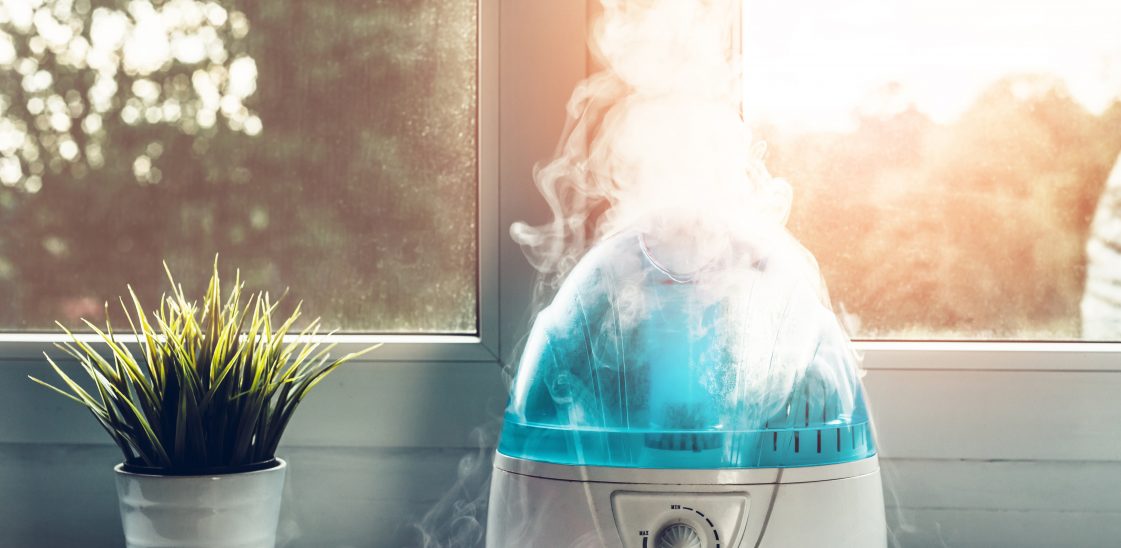
How to add moisture to a dry home
If the air in your home is too dry, your health may be affected in a number of ways. You may suffer from a sore throat, a cough, congestion, respiratory problems, sinus problems, irritated eyes, chapped lips, and headaches.
While it may be possible to alleviate some of these complaints by other means – for example, by using cough medicines, lip balms, or by taking painkillers – it’s important to get to the root of the problem in order to completely fix the issue.
To find out how you can restore the moisture levels in your space and make your home a more comfortable place to be, read on.
How to add moisture using a humidifier
The colder weather and lower humidity levels during winter can mean the air in your home can get especially dry. To counteract the drop in temperature, we tend to turn to indoor heating systems and fires – yet, unfortunately, they can exacerbate the problem by making the air even drier. So what’s the solution?
An easy way to restore the moisture levels in your home is to use a humidifier. These appliances, which usually run on electricity, can be used to rehydrate your whole house or parts of it.
There are several different types of humidifiers to choose from, including table-top designs that are intended for single-room use, larger free-standing units that can add moisture to large areas of your home, and whole-house humidifiers that need to be linked up with your home’s heating system.
You can also choose between warm mist humidifiers that use a heating element to create steam, cool mist designs that use a fan to evaporate water into the atmosphere, ones with UV light to sanitise the water being added to the air, ultrasonic versions which rely on vibrations to send microscopic water droplets into the environment, and more.
Although they may use different mechanisms, all humidifiers are created with the same purpose in mind – to add moisture to the air. Whichever design you go for, you should run the device in accordance with your particular needs, being sure to always carefully follow the operation, cleaning, and maintenance instructions that come with your humidifier.
What are humidifiers good for?
Humidifiers provide users with a relatively simple way to rebalance the moisture levels in the home. They offer a host of potential benefits. For example, they can:
- Limit the spread of viruses
Research suggests that dry air can spur on flu and other viral outbreaks. By regulating the humidity levels in your home, you may be able to help prevent viruses from spreading[1].
- Prevent irritation caused by dryness
If you suffer from dry, cracked skin during the winter months or you find that existing skin conditions, such as eczema or psoriasis, tend to flare up at this time of year, running a humidifier to add moisture to your indoor environment can help to keep your skin hydrated. Similarly, if you suffer from eye irritation during the cooler months, dry air may be the culprit. Having a humidifier in your home may help to soothe dry eyes and prevent them from becoming irritated in the first place. Increasing humidity can help with a host of other physical problems that can be caused by dry air, such as coughs, sore throats, and irritated nasal passages.
- Alleviate snoring
Upping the moisture levels indoors has even been known to reduce snoring. Running a humidifier can help to lubricate the nasal passages of snorers, which may help to alleviate their symptoms.
- Prevent nosebleeds
Anterior nosebleeds are often caused by dry indoor conditions. By adding moisture to the air, you can prevent the nasal passages from becoming dried out and crusted. This can help to prevent nosebleeds[2].
- Helping babies and small children with congestion
Many parents of babies and young children swear by humidifiers to help their children to breathe easier at night when they are congested due to a cough or cold. However, it’s important to ensure that the humidifier you choose is safe for use with children.
How humid should a room be?
While it’s important to raise the humidity levels in the home if they’re too low, if you increase them too much, you could be putting yourself at risk of a variety of other problems, such as mould, mildew, and fungi.
For an optimal environment for your home and your health, you should aim for an indoor humidity level of 30-60% during the cooler seasons. You can measure the moisture levels in your home by using a hygrometer.
If the humidity levels drop below 30%, you’re likely to start feeling the negative effects of dry air, such as respiratory problems. If the moisture levels go up to 70% or above, your home will become vulnerable to mould.
Does a humidifier help with a cough and a sore throat?
Yes, in some cases, a humidifier can help to relieve coughs and sore throats.
One of the side effects of dry air exposure is a tickly, unproductive cough. Adding moisture to the air can help you release trapped phlegm and clear your airways by making your cough productive[3].
Similarly, if you often wake up with a sore, dry throat, it may be that the moisture levels in your home are to blame. Using a humidifier can help to put much-needed moisture back into your airways and relieve the discomfort of a dry throat[4].
How to get moisture in the air without a humidifier
While a humidifier can be very beneficial, there are other ways you return lost moisture to the air if you don’t have one. Here are some simple ways you can add increase the humidity levels in your home without investing in a new appliance:
- Put damp laundry on radiators
Instead of opting to use the tumble dryer in the winter months, why not put your washed laundry on the radiators to dry instead? Doing this can return moisture to the air quickly and easily, and you’ll also get your clothes dry without the expense of running your dryer.
- Add houseplants to your home
All plants add some moisture to the air but some plants are particularly good humidifiers. Adding spider plants, English ivy, and peace lilies to your home, for example, will not only make your space more attractive but will also help to add humidity.
- Open the dishwasher when its cycle has finished
This is a super simple one that can have an instant impact on the moisture levels in your home. Instead of closing the dishwasher door when the cycle has completed, why not leave the door open and let that warm, moist air circulate around the room to help restore the humidity levels in your home?
- Keep pan lids off when cooking
Another easy one. Instead of trapping steam in your cooking pots and pans, keep the lids off and let the steam escape around your home to replenish the moisture in the environment.
- Use your extractor fan less often
Forgo your extractor fans and let the moisture-laden air from cooking, showering, and bathing circulate around your home instead of removing it. Of course, when employing these tips, it’s important to be careful you don’t overdo it and unwittingly create an environment that is too humid. If you’re not sure, you can use a hygrometer to check that the humidity levels in your home are well regulated.
Resources:
[1] https://www.nih.gov/news-events/nih-research-matters/dry-air-may-spur-flu-outbreaks
[2] https://www.nhs.uk/conditions/nosebleed/
